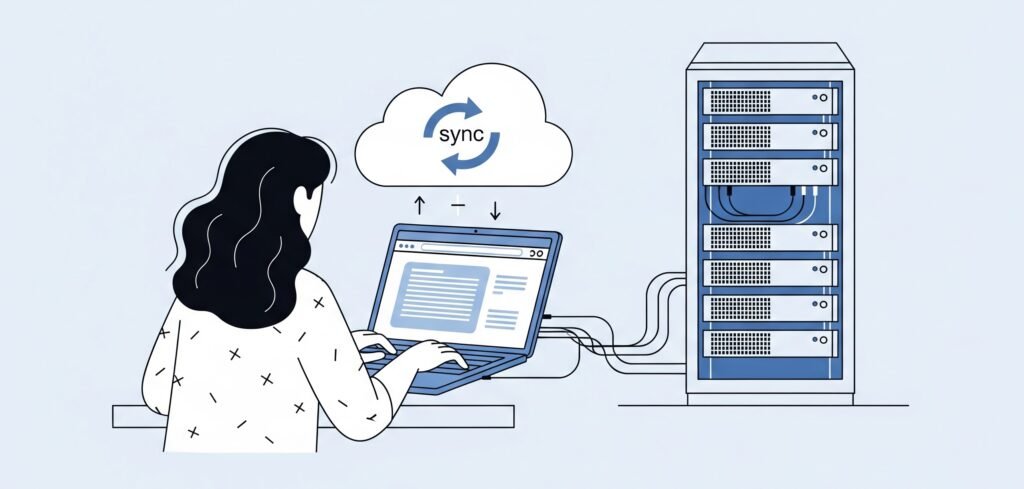
Have you ever wondered how websites magically appear in your browser when you type in an address? The secret behind it all is something called website hosting. It might sound technical, but it’s actually a straightforward concept once you break it down. In this beginner-friendly guide, we’ll walk you through what website hosting really is, how it works, and why it’s essential for anyone looking to build an online presence.
## Introduction
Why Understanding Website Hosting is Crucial
If you’re starting a blog, online store, or business site, you’re probably focused on design, branding, and content. But without website hosting, none of that matters. Hosting is the engine that powers your site, ensuring it’s online, accessible, and secure. It’s the foundation of your entire web presence.
Many beginners make the mistake of overlooking hosting or choosing the wrong type. This can lead to slow load times, crashes, or even complete website downtime. And let’s be honest—if your site isn’t live or reliable, what’s the point? Learning about hosting early helps you avoid headaches later and gives you more control over your digital brand.
Real-Life Analogy to Explain Hosting
Let’s simplify things. Imagine you want to open a shop. You’ll need two things:
- An address (domain name) so customers can find you.
- A physical space (hosting) to store and display your products.
In this analogy, your website’s domain name is the address, and web hosting is the building that holds your content—images, text, files, and everything else. Without hosting, your domain leads nowhere. Hosting is what makes your website accessible on the internet.
## Website Hosting Defined
What Exactly is Website Hosting?
Website hosting is a service that provides the storage space and infrastructure needed to make your website visible online. When someone visits your site, their browser connects to a server (a powerful computer) where your website’s data is stored. That server sends the website data back to the visitor’s device, allowing them to see your site in real-time.
These servers run 24/7, ensuring your site is always accessible. Hosting companies own and maintain these servers, and they rent out space on them to individuals and businesses. That’s what you pay for when you buy a hosting plan.
So in short, website hosting = renting space on the internet for your website files.
The Role of Hosting in Making a Website Live
Without hosting, your website simply cannot be accessed by others. Even if you’ve designed the perfect site using a tool like WordPress or Wix, it needs to be “published” somewhere so others can see it.
Once you have a hosting plan and upload your website files to the server, your site becomes live. Visitors can type your domain into their browser, and thanks to hosting, they’ll be directed to the right server, where your site is stored and displayed instantly.
Hosting also plays a critical role in:
- Website performance (loading speed)
- Site uptime (how often your site is available)
- Data storage (how much content your site can hold)
- Security (SSL certificates, firewalls, malware protection)
## How Website Hosting Works
Servers, Storage, and Bandwidth Explained
Let’s get a little technical—but not too scary.
- Server: This is a high-powered computer that stores your website files (HTML, CSS, images, etc.) and delivers them to users when they visit your site.
- Storage: Think of this like a hard drive. It holds all your website content. The more content you have, the more storage you’ll need.
- Bandwidth: This is how much data can be transferred from your website to visitors in a given time. Higher bandwidth allows more people to access your site at the same time without slowing it down.
When someone visits your site, a request is sent to your server. The server pulls the files, transmits the data through the internet, and your website appears on their screen. All this happens in less than a second.
The Journey from Domain to Browser

Here’s a simplified version of what happens behind the scenes:
- A user types your domain (e.g., www.arkwebtech.com).
- The domain connects to your hosting provider’s server.
- The server finds the correct files (like homepage content, images).
- These files are sent back to the user’s browser.
- Your website loads and is fully interactive.
This seamless experience depends heavily on your hosting provider’s infrastructure and technology. That’s why choosing a reliable host is key to your website’s success.
## Types of Web Hosting
Shared Hosting
Best for: Beginners, small websites, personal blogs
Shared hosting means your website shares a server with multiple other websites. It’s like renting an apartment in a big building—everyone shares the same utilities.
Pros:
- Very affordable
- Easy to set up
- Great for small traffic websites
Cons:
- Limited resources
- Slower if neighboring sites get high traffic
- Less control over settings
VPS Hosting (Virtual Private Server)
Best for: Growing websites, small businesses, developers
VPS hosting offers more power and flexibility. It’s still a shared environment, but each website gets a dedicated portion of server resources.
Pros:
- More control
- Better performance
- Scalable
Cons:
- More expensive than shared
- Requires some technical knowledge
Dedicated Hosting
Best for: Large businesses, high-traffic sites, custom applications
With dedicated hosting, you get an entire server to yourself. It’s like owning a house instead of renting.
Pros:
- Maximum performance
- Full customization
- Highest security
Cons:
- Expensive
- Requires technical expertise
Cloud Hosting
Best for: Websites that need scalability and reliability
Cloud hosting uses multiple servers connected in a network. If one server goes down, another takes over.
Pros:
- Highly scalable
- Great uptime
- Pay-as-you-go pricing
Cons:
- Can get pricey
- Some providers have complex pricing structures
Managed WordPress Hosting
Best for: WordPress users who want hassle-free hosting
Managed WordPress hosting is optimized specifically for WordPress sites, with updates, backups, and security handled for you.
Pros:
- Optimized performance
- Security and updates managed
- Great support
Cons:
- More expensive than standard shared hosting
- Limited to WordPress-only sites
## Shared vs. Dedicated Hosting: Key Differences
Performance, Cost, and Control

When it comes to choosing between shared and dedicated hosting, the decision often boils down to three major factors: performance, cost, and control.
Shared Hosting is ideal for those just starting out. Since you’re sharing server resources with other websites, the cost is significantly lower. However, that means performance can suffer, especially if your neighboring websites get a lot of traffic or use excessive resources. You also have limited control over server settings, which may be fine for beginners but limiting for growing businesses.
Dedicated Hosting, on the other hand, gives you full control and an entire server to yourself. This guarantees consistent performance, more security, and the ability to customize everything to your needs. But it comes with a much higher price tag and requires some technical skills to manage efficiently.
Here’s a quick comparison:
| Feature | Shared Hosting | Dedicated Hosting |
|---|---|---|
| Cost | Low | High |
| Performance | Can be affected by others | Very high and stable |
| Server Control | Limited | Full |
| Technical Skills | Not required | Often required |
| Security | Standard | High |
When to Choose Which
- Choose Shared Hosting if you’re launching a personal blog, small portfolio, or a startup website with minimal traffic. It’s budget-friendly and requires zero technical know-how.
- Choose Dedicated Hosting if you run an e-commerce platform, membership site, or high-traffic business site. You’ll get the performance and control needed to scale securely and reliably.
The key is to align your hosting choice with your website’s current size and future goals. Don’t overpay for power you don’t yet need, but don’t limit growth by staying too small for too long.
## What You Need to Host a Website
Domain Name and Hosting Account
To get your website online, you need two essentials:
- A Domain Name – This is your website’s address, like www.yourbrand.com. You can register this through a domain registrar such as GoDaddy, Namecheap, or directly through your hosting provider.
- A Hosting Account – This is where all your website files live. You sign up with a web hosting provider (e.g., Bluehost, SiteGround, Hostinger) and rent server space.
Some hosting companies offer a free domain with their hosting plans, which simplifies the process.
Website Files and CMS (Content Management System)
Your website is made up of files—HTML, CSS, images, scripts, etc.—that need to be stored on the server. If you’re building your site from scratch, you’ll upload these manually via FTP.
Most people use a CMS (Content Management System) like:
- WordPress
- Wix
- Squarespace
- Shopify
A CMS lets you build and manage your site without coding. Hosting providers usually have 1-click installations for popular CMS platforms, making it super easy to get started.
To summarize, hosting a website involves:
- Buying a domain
- Setting up a hosting plan
- Installing your CMS or uploading files
- Publishing your content
With these pieces in place, your website goes live for the world to see.
## Popular Website Hosting Providers
Overview of Top Hosting Companies
The market is full of hosting providers, but not all are created equal. Some are known for blazing speed, others for unbeatable support. Here are some of the most trusted names in the industry:
- Bluehost: Officially recommended by WordPress, known for beginner-friendly plans and great support.
- SiteGround: Offers fast and secure hosting with excellent uptime and customer service.
- Hostinger: Budget-friendly option with surprisingly good performance.
- A2 Hosting: Focused on speed and developer-friendly features.
- DreamHost: Long-time provider with transparent pricing and solid performance.
- GoDaddy: One of the largest domain registrars that also offers hosting services.
Choosing the right host depends on your priorities: budget, performance, scalability, or support.
Features to Look for in a Hosting Service
Before you commit to a hosting provider, consider the following essential features:
- Uptime Guarantee (99.9% or higher): Ensures your website is almost always accessible.
- Fast Load Times: Speed is crucial for both user experience and SEO.
- Free SSL Certificate: Secures your site and boosts Google rankings.
- Easy Control Panel (like cPanel): For managing domains, emails, and settings.
- Customer Support: 24/7 live chat or phone support is a must-have.
- Backup Options: Automatic site backups give you peace of mind.
- Scalability: The ability to upgrade your plan as your site grows.
A good hosting provider will offer all these without hidden fees or upsells that drain your wallet.
## How to Choose the Right Hosting Plan
Key Factors: Speed, Uptime, Support, Pricing
When selecting a hosting plan, balance your needs with what each provider offers. Here’s what you should be evaluating:
- Speed: Look for SSD storage, caching tools, and CDN support.
- Uptime: Anything below 99.9% is risky.
- Support: 24/7 customer service, preferably live chat and phone.
- Pricing: Check both initial and renewal prices—there’s often a big jump!
- Scalability: Can you upgrade as traffic increases?
- Security: Free SSL, malware scanning, and firewalls are a must.
- Ease of Use: User-friendly dashboards help you avoid tech headaches.
Matching Hosting Type with Website Goals
- Personal Blogs or Portfolios: Shared hosting is sufficient.
- E-commerce or Business Sites: Go for VPS or managed WordPress hosting.
- High-Traffic or Media-Rich Sites: Choose dedicated or cloud hosting.
- Developers or Tech-Savvy Users: VPS or cloud with root access provides flexibility.
Choosing the right hosting plan is like choosing the right vehicle—you wouldn’t buy a sports car if you just need a daily commute car. The same goes for hosting—pick what fits your journey, not just what looks shiny.
